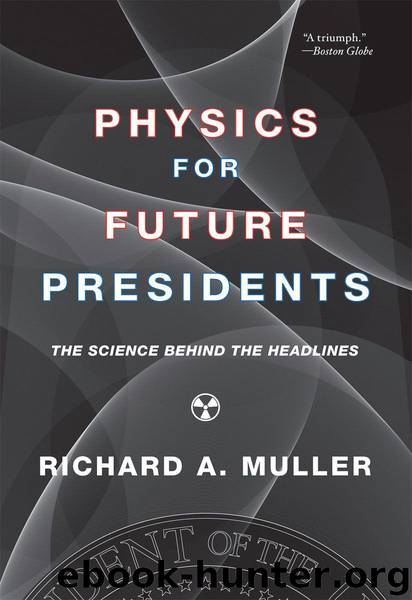Physics for Future Presidents by Richard A. Muller

Author:Richard A. Muller
Language: eng
Format: mobi, epub, azw3
Tags: Nightmare
Publisher: W. W. Norton & Company
Published: 2008-08-17T00:00:00+00:00
Cold Fusion
Heat was once thought necessary for fusion because the deuterium and tritium nuclei repel each other. In 1957, Luis Alvarez (my mentor) and his colleagues discovered a remarkable way to cancel that repulsion, thereby eliminating the need for high temperature. The key is an elementary particle called a muon that is created in the atmosphere by cosmic rays. It has negative charge, and when it slows down it sometimes sticks to a nucleus.40 When it sticks to a hydrogen (or heavy hydrogen) nucleus, its negative charge cancels the proton’s positive charge. This electrically neutral nucleus then feels no repulsion from other hydrogen nuclei. It wanders around through the fluid (just from its thermal motion) until it gets close to another hydrogen nucleus—close enough for the nuclear force to bring the two nuclei together in fusion. The fusion releases huge energy, and usually ejects the muon. The freed neutron is then attracted to another hydrogen nucleus. It neutralizes that one, and the process begins again. The muon is said to be a catalyst because it comes back again and again to keep working its magic. When Alvarez discovered this process and finally understood what was happening (after consulting with Edward Teller), he told me that his excitement was indescribable. It seemed that he had found a simple method of supplying humans with all the energy they would need for the indefinite future.
Unfortunately, it turned out that there was no practical way to make use of this muon-catalyzed fusion. The problem is that the muon sometimes sticks to the fused helium, and then it no longer triggers additional fusions; it stops working as a catalyst. This happens before enough energy is released to make another muon, so there is no net energy gain. Scientists are still experimenting with different pressures and temperatures in the hope that muon-catalyzed fusion will someday work, but I am not optimistic.
The fact that this technique almost worked has given people hope that other approaches toward cold fusion could succeed. In 1989, two chemists—Stanley Pons and Martin Fleischmann—thought they had achieved cold fusion using a palladium catalyst, but their discovery was based on a mistaken interpretation of their data. Other cold fusion has been reported from time to time. Although there is no proof against it (after all, Alvarez did see a kind of cold fusion), most experts are pessimistic. The reason is that there are no other suitable replacements for the muons used by Alvarez. Other chemical processes typically have energy per atom that is a million times too small to allow the nuclei to approach each other.
The whole field is distorted by the fact that anyone who discovers cold fusion will (1) win a Nobel Prize, (2) become a multibillionaire, and (3) be known in history as the person who solved the world’s energy needs. As a result, when someone sees something that looks like cold fusion (but isn’t), it is so exciting that there is a strong tendency to want to believe that a real discovery has been made, and to keep all the details secret—until they are patented.
Download
Physics for Future Presidents by Richard A. Muller.epub
Physics for Future Presidents by Richard A. Muller.azw3
This site does not store any files on its server. We only index and link to content provided by other sites. Please contact the content providers to delete copyright contents if any and email us, we'll remove relevant links or contents immediately.
The Complete Stick Figure Physics Tutorials by Allen Sarah(6638)
Secrets of Antigravity Propulsion: Tesla, UFOs, and Classified Aerospace Technology by Ph.D. Paul A. Laviolette(3445)
Thing Explainer by Randall Munroe(3327)
The River of Consciousness by Oliver Sacks(2992)
The Order of Time by Carlo Rovelli(2714)
I Live in the Future & Here's How It Works by Nick Bilton(2524)
A Brief History of Time by Stephen Hawking(2473)
How To by Randall Munroe(2473)
The Great Unknown by Marcus du Sautoy(2185)
What If?: Serious Scientific Answers to Absurd Hypothetical Questions by Randall Munroe(2170)
Blockchain: Ultimate Step By Step Guide To Understanding Blockchain Technology, Bitcoin Creation, and the future of Money (Novice to Expert) by Keizer Söze(2136)
Midnight in Chernobyl by Adam Higginbotham(2077)
Networks: An Introduction by Newman Mark(1997)
The Meaning of it All by Richard Feynman(1909)
Easy Electronics by Charles Platt(1864)
The Tao of Physics by Fritjof Capra(1848)
When by Daniel H Pink(1777)
Midnight in Chernobyl: The Untold Story of the World's Greatest Nuclear Disaster by Adam Higginbotham(1775)
Introducing Relativity by Bruce Bassett(1754)
